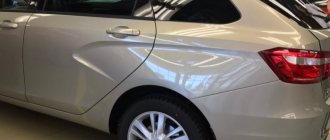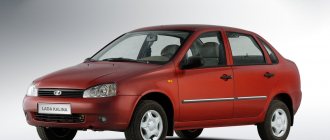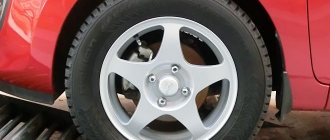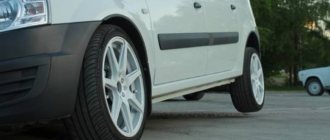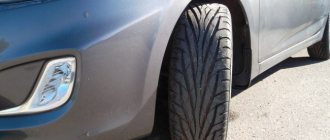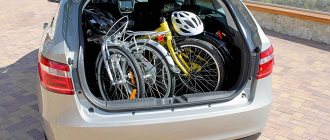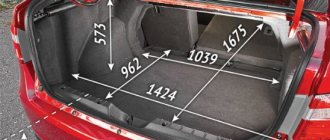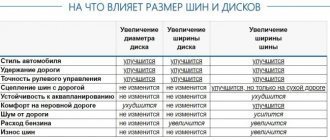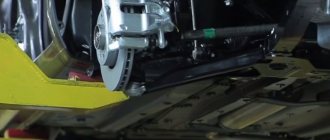February 27, 2021 Lada.Online 65 762 26
AVTOVAZ recommends installing only one size of tires and wheels on the Cross and Sport versions (on Vesta Cross, XRAY Cross and Vesta Sport only 17-inch wheels, on Largus Cross only R16, and Granta Cross only R15). These permissible tire and wheel sizes are indicated in the vehicle owner's manual. However, when checking a car, government agencies are guided by the requirements that are specified in the documents drawn up when certifying a car before starting sales in the country - VTTS (Vehicle Type Approval). The Lada.Online website studied these documents and discovered an interesting feature.
The OTTS number is indicated in the title of your vehicle. We find it on the Internet and look at the acceptable tires.
photo lanc06
What does the size of tires and wheels affect?
| Increasing disc diameter | Increasing rim width | Increasing tire width | |
| Car style | will improve | will improve | will improve |
| Road holding | will improve | will improve | will improve |
| Steering precision | will improve | will improve | will improve |
| Tire grip | Will not change | Will not change | will improve, but only on dry roads |
| Resistance to hydroplaning | Will not change | Will not change | will get worse |
| Comfort on rough roads | will get worse | Will not change | will improve |
| Road noise | Will not change | Will not change | will intensify |
| Gasoline consumption | Will not change | will increase | will increase |
| Tire wear | Will not change | Will not change | will increase |
If you are going to buy winter tires for your Lada Vesta, then try to choose narrower tires.
These tires will create more pressure on the road surface and improve traction. Remember that wide tires are more sensitive to ruts in winter. And low-profile tires make the ride less comfortable, because... transfer even the smallest holes to the body. The smaller the unsprung mass (this includes the mass of tires and wheels), the better the car will hold the road and accelerate faster. For example, if you put wheels on a car that are 2 kg lighter each, then acceleration to 100 km/h will be reduced by 0.2 seconds.
Attention! Installing larger wheels may lead to problems with ABS and ESP calibration (the systems may not work correctly).
You can buy rims for Lada Vesta at the lowest prices from us.
What wheels and tires did you choose for the Lada Vesta? What are the pros and cons of such a replacement? Participate in the survey, leave feedback and ask questions. Let us remind you that in this article we determine the real fuel consumption of this car.
Keywords: Lada Vesta wheels | Lada Vesta tires
Share on social networks:
Found an error? Select it and press Ctrl Enter..
Appearance of Lada Vesta Cross: choice of roller
In stamped rollers, the appearance depends on which stamp was chosen for their manufacture, while in cast rollers, milling and computer graphics are used. Often, owners find other ways to make the car original, for example, installing r16 wheels instead of 15 on the Lada Vesta SV Cross. This leads to the following:
- The steering becomes better, the car holds better on the road, but when driving on uneven roads, the ride comfort decreases;
- The traction indicator in dry weather increases, but fuel consumption increases, tires wear out faster, noise insulation and stability during aquaplaning decrease.
Basic dimensions of wheel bolts on Lada vesta:
As a standard, Lada Vesta is equipped with bolts with metric threads, diameter 12 (mm), thread pitch - 1.5 (inches) and radius between bolts 100 (mm).
Characteristics of Lada Vesta wheel bolts:
- External thread diameter: 12 (mm);
- Thread pitch: 1.5 (inch);
- Number of bolts: 4 (pcs);
- Radius between bolts: 100 (mm);
- Disc offset: 60.1 (mm).
Important: the number of revolutions when tightening the disc bolts should not be less than 7-9. If the speed is lower, the risk of losing a wheel while driving increases.
Years of release: currently in production.
| General parameters of $iden Lada Vesta wheels | |||
| Drawing General schematic drawing of wheel bolts | Quantity (pcs) Number of fasteners per hub for Lada Vesta. | ||
Thread M14 x 1.5 means:
M14 – thread diameter 14 (mm); 1.5 — thread pitch (distance between adjacent threads).
To fasten wheels or disks, 2 main types of fasteners are used:
- wheel bolts; -wheel nuts.
| Size (mm) Metric Fastener Size: | Type Wheel mounting type: | ||
| (bolt drawing) | 4 things) | M12x1.5 | Bolt |
| $iden Lada Vesta wheel size tables | ||||
| Year Number of fasteners per hub for Lada Vesta. | Quantity (pcs) Metric Fastener Size: | |||
Thread M14 x 1.5 means:
M14 – thread diameter 14 (mm); 1.5 — thread pitch (distance between adjacent threads).
The diameter of the circle on which the mounting holes for Lada Vesta are located.
1. The distance between the vertical plane of symmetry of the wheel and the plane of application of the disk to the hub.
Caution: the above data are the official figures of the manufacturer, however, please note that the information is for reference only and does not guarantee absolute accuracy.
Hello, my dear reader!
I decided to protect the wheels from freebie lovers. The most accurate option is “secrets”. Previously, I only dealt with nuts, but suddenly there are bolts! But what kind of bolts are needed for Vesta? M12 x 1.5. They fit perfectly. Detailed parameters in the photo.
It's starting to get warmer outside, and you need to change your tires from winter to summer. As a rule, I change the whole thing - wheels, winter tires on original stamps, summer tires (original Pirelli) on Chinese-made NZ alloy wheels - 15 in diameter. Vesta inherited 4 bolts M12x1.5 from Renault, but Renault was equipped with 14 in diameter, and Vesta uses tires from 15 to 17.
For such dimensions, I think 4 bolts are not enough, or right next to each other - competitors use five fastening points. I rolled summer tires on alloy wheels for the 2nd season using the original bolts, unscrewing them in the fall and counted the number of threads on which they are held, the result did not suit me, the front wheels were held by about 4.
5 turns, rear - approximately 8.5. The number of turns on the front ones turned out to be less due to grooves in the brake discs, and I consider it insufficient. It was decided that the bolts should be selected longer - taking into account the thread pitch of 1.5 and the length of the standard ones (24mm), I decided that at least 7 turns would be enough, so I chose a thread length of 28 mm. The Chinese “Wheel Fasteners”, “Matrix” and the Italian “Bimecc” turned out to be available for order, so I settled on it,
its catalog number is C17A28. (I love Italian things). As a result, it turned out that the front wheels are screwed on with at least 7.5 turns, the rear wheels with about 12 turns. I was afraid that the bolts would touch something because of their length, but everything is fine, they don’t interfere with anything or touch anything.
I cover the bolt caps with caps with catalog number 321601173A, which were purchased inexpensively on AliExpress (the search engine finds them in AliExpress by number), and the emblem of the central wheel cap NZ was also replaced using a Lada sticker.
Note: The tightening torques for engine parts are given in more detail here
| Size (mm) Diameter between fasteners: | PCD (mm) Disc offset: | ET (mm) | ||
| 1.6i | ||||
| 2021 | 4 | M12x1.5 | 100 | 60.10 |
| 2021 | 4 | M12x1.5 | 100 | 60.10 |
| 2021 | 4 | M12x1.5 | 100 | 60.10 |
| 2021 | 4 | M12x1.5 | 100 | 60.10 |
| 1.8i | ||||
| 2021 | 4 | M12x1.5 | 100 | 60.10 |
| 2021 | 4 | M12x1.5 | 100 | 60.10 |
| 2021 | 4 | M12x1.5 | 100 | 60.10 |
| 2021 | 4 | M12x1.5 | 100 | 60.10 |
| Detail | Tightening torque, Nm |
| Engine | |
| Cylinder head bolt | see here |
| Nut and bolt securing the intake pipe | 2,1-2,5 |
| Collector fastening nut | 21-25 |
| Additional muffler clamp nut | 14-16 |
| Automatic camshaft belt tensioner bolt | 30-36 |
| Bolt securing the bracket for auxiliary units M8/M10 | 15-24/33-52 |
| Accessory belt tensioner nut | 30-36 |
| Camshaft bearing housing bolt | 8-10 |
| Camshaft pulley bolt | 70-83 |
| Thermostat housing mounting nut | 16-22 |
| Oil sump bolt | 5-8 |
| Flywheel bolt | 75-85 |
| Water pump mounting bolt | 7-8 |
| Crankshaft pulley bolt | 95-115 |
| Muffler exhaust pipe fastening nut | 21-25 |
| Oil pump mounting bolt | 9-10 |
| Cylinder head cover bolt | 7-9 |
| Oxygen concentration sensor | 40-60 |
| Oil pressure warning sensor | 35 |
| Knock sensor mounting bolt | 11-24 |
| Crankshaft position sensor mounting bolt | 8-12 |
| Throttle assembly nut | 5-8 |
| Fuel rail mounting bolt | 9-14 |
| Clutch | |
| Bolt securing the basket to the flywheel | 20-31 |
| Bolt securing the slave cylinder to the clutch housing | 18-24 |
| Transmission | |
| Bolt securing the gearbox (clutch housing) to the engine | 60-80 |
| Drain plug | 29-46 |
| Filler plug | 29-46 |
| Nut securing the rocker to the body base | 14-20 |
| Front suspension | |
| Bolt securing the subframe to the body | 94-126 |
| Bolt securing the upper support of the shock absorber strut to the body | 18-24 |
| Bolt securing the shock absorber strut to the steering knuckle | 90-120 |
| Bolt securing the rear suspension arm hinge to the subframe | 94-126 |
| Bolt securing the front suspension arm hinge to the subframe | 94-126 |
| Rear subframe extension bolt | 7-9 |
| Front subframe extension bolt | 38-50 |
| Stabilizer link pin fastening nut | 53-71 |
| Bolt securing the stabilizer bar to the cross member | 18-24 |
| Nut securing the shock absorber rod to the upper support | 53-71 |
| Nut securing the ball joint to the steering knuckle | 53-71 |
| Wheel bearing nut | 238-322 |
| Wheel bolt | 90-120 |
| Rear suspension | |
| Shock absorber lower mounting bolt | 90-120 |
| Rear suspension arm mounting nut | 106-143 |
| Suspension arm bracket mounting bolt | 90-120 |
| Upper support nut | 53-71 |
| Shock absorber rod mounting nut | 30-40 |
| Trunnion bolt | 90-120 |
| Wheel bearing nut | 158-192 |
| Wheel bolt | 90-120 |
| Steering | |
| Bolt securing the steering gear to the subframe | 153-207 |
| Steering column mounting nuts | 18-24 |
| Steering column intermediate shaft terminal connection bolt | 53-71 |
| Steering wheel bolt | 38-50 |
| Tie rod end locknut | 15-21 |
| Rod end ball pin fastening nut | 32-42 |
| Attaching the drive rod joint to the rack | See here |
| Brake system | |
| Vacuum booster mounting nut | 18-24 |
| Brake disc bolt | 12-16 |
| Bolt securing the shoe guide to the steering knuckle | 90-120 |
| Guide pin bolt | 26-31 |
| Brake shield mounting bolt | 7-9 |
| Rear brake cylinder mounting bolt | 7-11 |
| Brake pipe fitting nut | 14-20 |
| ABS hydroelectronic module bracket mounting nut | 18-24 |
| Electrical equipment | |
| Nut securing the terminal to the battery | 4-6 |
| Headlight mounting bolt | 3-5 |
| Rear light fastening nut | 2-3 |
| Generator mounting bolt | 21-27 |
| Nut securing the power wire terminal to the generator | 10-13 |
| Starter mounting bolt | 18-24 |
| Nut securing the power wire terminal to the starter | 10-13 |
New Lada: Repair of the standard armrest of Lada Vesta
Note. For other threaded connections, the tightening torques are as follows: M6 - 10 Nm; M8 - 25 Nm; M10- 50 Nm; M12 - 105 Nm; M14 - 180 Nm.
Lada Vesta left the assembly line in 2022. Belongs to the class of domestically produced sedans. This is where the general ends, and the specific features begin.
Factory Vesta tires and wheels
| Modification | Tire size with load capacity and speed indexes* | Disk options | ||||
| DIA, mm | PSD, mm | Number of holes for fastening, pcs. | rim width (inches) | rim offset (ET), mm | ||
| Installed by the manufacturer | ||||||
| Sedan and station wagon | 185/65 R15 88H | 60.1 | 100 | 4 | 6J | 50 |
| 195/55 R16 91Н | ||||||
| Cross | 205/50 R17 89V | 61/2J | 43 | |||
| 205/50 R17 93W | ||||||
| Sport | 205/50 R17 (93/89, W/V) | 66.1 | 114.3 | 5 | 61/2J | 50 |
| Allowed to be installed during operation | ||||||
| Sedan and station wagon | 185/65 R15 88T, H | 60.1 | 100 | 4 | 5J, 51/2J, 6J, 61/2J | 50 |
| 195/55 R16 87, 91T, H | 51/2J, 6J, 61/2J | |||||
| Cross | 205/50 R17 89H,V | 43 | ||||
| 205/50 R17 93W | ||||||
* Speed indices: T – up to 190 km/h, H – up to 210 km/h. Load capacity indices: 88–560 kg; 91–615 kg.
In September 2022, the “Operating Manual for LADA Vesta dated 09.09.16” was posted on the official website, in which an addition to Table 1 appeared (more about this):
| Specifications | Meaning | ||||
| Engine | 21129 (1.6l, 16kl) | 21179 (1.8l, 16kl) | |||
| Transmission type | MT JH3 514 | MT 21807 | AMT 21827 | MT 21807 | AMT 21827 |
| Tire size | 195/65R15, 205/55R16, 205/50R17 | ||||
AVTOVAZ response:
According to the information given in the vehicle's Operation Manual, the composition of the vehicle and its configuration are constantly updated; you can use all current standard sizes.
Lada Vesta SV 2022 1.6i
Engine: VAZ-21129, I4, Gasoline Power: 106 hp
(78 kW)Options: Classic + Start, Comfort, Luxe Wheel rim bolt pattern parameters
| PCD (number of holes x circle diameter) | 4×100 mm |
| Center Hole Diameter (DIA) | 60.1 mm |
| Fasteners | M12 x 1.5 |
| Type of fastener | Bolt |
| Tires | Discs | PCD | Dia | Pressure |
| 185/65 R15 88H Factory kit | 6Jx15 ET50 | 4×100 | 60.1 | 2.2 |
| 185/65 R15 88T Factory kit | 6Jx15 ET50 | 4×100 | 60.1 | 2.2 |
| 195/55 R16 91T Factory kit | 6Jx16ET50 | 4×100 | 60.1 | 2.2 |
| 185/60 R16 86S Tuning | 6Jx16ET50 | 4×100 | 60.1 | 2.1 |
| 195/50 R17 89H Tuning | 6.5Jx17 ET48 | 4×100 | 60.1 | 2.3 |
| 205/50 R17 92V Tuning | 6.5Jx17 ET45 | 4×100 | 60.1 | 2.3 |
What wheel sizes does the manufacturer recommend to install?
The Lada Vesta SV 2022 1.6i is equipped as standard with 6Jx15 ET50 wheel rims assembled with 185/65 R15 88H tires. Where:
- 6J - rim width in inches;
- 15″ — tire diameter in inches;
- ET50 - disc offset in millimeters.
The vehicle tire marking 185/65 R15 is deciphered as follows:
- 185 — profile width (cross section of the tire) in millimeters;
- 65 — profile height as a percentage of its width;
- R - radial cord winding;
- 15 is the tire diameter in inches.
In addition, information about its load capacity and speed parameters can be printed on the rubber - load index and speed index. The load index is a two- or three-digit number; the speed index is indicated in Latin letters, for example 88H:
- 88 - maximum permissible tire load 560 kg;
- H — maximum permissible vehicle speed is 210 km/h.
Using the recommended tire sizes will help you avoid problems with handling, safety and other difficulties. What non-standard sizes can be supplied? Refer to the table; it indicates possible acceptable alternative sizes for tuning. Although there are other options that we have not described in the table. For example, wider discs of the same diameter. Or install wheels of the same width, but with a larger diameter, which is quite popular among car owners. The choice of discs is huge; you can find copies with the same parameters, but with an overhang 1-2 millimeters more or less. It is not possible to list all the options.
At the same time, the bolt pattern for all types of wheels is the same - 4x100. Thus, all disks are mounted with four bolts and the distance between them is exactly one hundred millimeters. The diameter of the car's hub is 60.1 mm.
How to choose stamped products
Wheel rims produced by stamping are among the most common for Vesta, installed at the factory. This is due to the low cost of production, since the material is ordinary steel.
When it comes to design, these wheels are the least attractive. Very often, car owners cover them with plastic caps to give the car a more attractive appearance.
All products produced by stamping are similar. They differ only in size and bolt pattern parameters. They may have different diameters of holes for the hubs. For Vesta, it is recommended to purchase such models with a radius of 15 inches. This is the most optimal size for this car, as it does not degrade factory characteristics.
However, they have many positive aspects:
- Greater strength compared to casting and forging.
- Better shock tolerance.
- Lower cost.
- More convenient and cheaper repairs.
The basic Lada Vesta has factory-installed wheels with a radius of R15 with tires that have the characteristics of 175/70 R15. Drilling or bolting parameters are the same for all types of products, both stamped and cast.
"Lada Vesta" with stamped wheels
Alternative to standard disks for Vesta
Mainly just to give the car a more attractive appearance, many motorists install larger wheel rims on the Lada, namely R17 and R18. This means using tires with a low profile, which is associated with discomfort when driving over uneven surfaces. However, some car enthusiasts prefer to sacrifice convenience for the sake of beauty.
17th radius
R17 are considered the most popular alternative rollers for Vesta. They stand out against the background of the standard 15s. For these, tires with sizes 175/55 and 195/50 are suitable. Of course, the larger the radius, the higher the price. Therefore, on average, you will have to pay about 3,000 and 5,000 rubles for stamped and cast ones, respectively. Products of top-rated foreign manufacturers, namely castings with a beautiful and unusual design, can be valued at 15,000 or more.
They were first shown in the concept version. Later, rollers of such a large size appeared on the Lada Vesta Sport and in the Exclusive configuration. The cost of disks is much more expensive than standard ones, so castings with an 18 radius are estimated at at least 9,000 rubles. Tires for such rollers have a size of 235/45, their price can also be expressed in large numbers.
Alternative color combinations
The latest fashion trends have been to combine different colors to create a contrast with the body shade. It is not surprising that now you can find products not only of all kinds of designs, but also of various colors.
For example, black discs are installed on a white Vesta for contrast. And, conversely, white ice skating rinks look great against a black background. Silver (classic) is suitable for cars of any color, as it is a universal option.
The best manufacturers of alternative drives for Vesta
Among the manufacturers of rollers with a radius of 17 and 18 for Vesta there are both Russian companies and foreign ones from different countries. Among them we will highlight the most popular.
| Brands | Manufacturers |
Minuses
How to choose the right wheels for the Lada Vesta St. Cross 2022?
3 types of rims:
- Stamped (economical price category) - made from a sheet of iron by stamping on a press.
- Light alloy - manufactured by casting (more reliable than stamped ones).
- Forged (the highest quality and more expensive than the previous ones) - made from light alloys by stamping at high temperatures.
The choice depends on financial capabilities. However, it should be borne in mind that the quality of the road surface on which you have to drive every day must also be taken into account.
So, if it gets into a hole, a stamped disk will bend and will not cause harm to the tire, but a forged or cast one can cut it. There is a possibility that the cast disc may burst or crack.
It should also be noted that repairing “stamping” wheels is cheaper than repairing cast or forged wheels. But wheels with high-quality cast and forged disks kill the suspension less, because lighter and have more perfect geometry (better balanced).
The same wheels may or may not rub with tires on the same car - wheel alignment adjustment will help here.
Wheels for top assemblies of Lada Vesta SV
More expensive Vesta configurations are supplied from the factory with slightly different ramps than the basic ones, namely 195/55R1691Н. These tires are the German EcoContact model produced by a company such as Continental and come in pairs with Ptalomey-16 alloy wheels, which have a tire mounting dimension of 6Jx16ET504x10060.1 corresponding to the tires.
As for wheels of the maximum size, for example, the Luxe version of this car is equipped with Ptalomey-17 wheels or, in other words, 17-inch wheels.
It should be borne in mind that the basic assemblies of the Lada Vesta SV can be equipped with such wheels for additional money.
Regarding the compliance of standard and AvtoVAZ-approved tires and wheels, this information is presented in a tabular format:
Which discs are better?
Class B and C cars often leave the factory on stamped wheels - at least in the basic configuration. They are cheaper, and the manufacturer, naturally, saves money - after all, on the scale of serial production, the difference in the finances spent on wheels becomes very significant.
However, steel, or as they are commonly called, iron disks, are cheaper not because they are inferior in performance - they are simply manufactured using cheaper technology and covered with paints and materials that are simpler in composition.
As for the mechanical properties of iron, they even have some advantages over casting. In particular, upon impact, the disk does not crack, but only crumples, which makes the product more repairable.
By and large, stampings have only one drawback - they do not look very presentable. To somehow improve it, you need to buy caps, the price of which varies between 400-700 rubles. a piece.
The result is almost the same as installing inexpensive castings, but if you already have steel wheels, then the option with hubcaps, of course, makes more sense.
The design of the alloy wheel and the cap may be the same, and at first glance you won’t even be able to tell what it is
The only problem is that the bolts securing the cap are unscrewed due to vibration, and it can easily get lost. The prospect of running around the shops in search of the same thing appeals to few people (and most often it is not possible to find a replacement at all).
That is why the vast majority of car enthusiasts still prefer alloy wheels. But what kind of choice there is in stores today, we will talk about this further.
What non-standard wheels will fit on the Lada Vesta
Although most car owners tend to enlarge their wheels to improve the appearance of the car, sometimes the opposite happens. For example, it is common practice to drive on larger diameter alloy wheels in the summer, and then take smaller wheels and a larger tire in the winter to make the car more controllable and softer on snowy roads.
New Lada: Engine in Lada Vesta
As for the maximum diameter, the critical height of the wheel assembly for Vesta is 660 millimeters. Therefore, not only the original 17-inch wheels are installed on the car, but also wheels with tires with a diameter of 18 inches. In this case, the tires should be no larger than 225/45 R18, and for some car owners they already cling a little to the wheel arch liners.
True, on drive2 there is a case with installing 19-inch wheels, but this will require improvements in the suspension design. And in the case of installing 18-inch wheels, some tire sizes also allow you to lower the car, which many do.
Is it possible to reduce the offset and install wider wheels? Do not forget that the manufacturer already recommends installing 17-diameter tires on 6.5-inch wide wheels with an offset of 43. That is, there are not many options here. The maximum permissible width of wheels on Vesta is 8 inches with an offset of 38.
In this arrangement, the wheels practically do not stick out and do not touch the arches. Anything more requires modification of the machine design. By the way, don’t forget that a smaller offset reduces the life of your wheel bearings. So you will have to either change it more often, or buy more expensive parts.
We also remind you that any replacement of wheels with non-standard sizes has advantages and disadvantages. By installing larger tires and wheels you will definitely improve the appearance of your car, its dynamics and stability. But you will have to pay for this with less comfort on bad roads and a possible increase in fuel consumption.
In the case of low-profile tires, which will most likely have to be placed on large rims, you will also have to get used to constantly monitoring the tire pressure, because the tires are more sensitive to this important parameter, as well as to shaking on uneven roads.
Alternative wheel options for Lada Vesta are in the table.
| Diameter | Tire size | Disk options | Height of wheel assembly, mm |
| 15″ | 175/70 R15 | 6J with offset 45-50 | 626 |
| 185/65 R15 | 6-6.5J with offset 45-50 | 621,5 | |
| 195/65 R15 | 6-7J with offset 45-50 | 634,5 | |
| 205/60 R15 | 6-7.5J with offset 45-50 | 627 | |
| 16″ | 175/70 R16 | 6J with offset 45-50 | 651,4 |
| 185/60 R16 | 6.5J with offset 45-50 | 628,4 | |
| 195/55 R16 | 6-7J with offset 45-50 | 620,9 | |
| 205/55 R16 | 6-7J with offset 45-50 | 631,9 | |
| 205/60 R16 | 6-7J with offset 45-50 | 652,4 | |
| 17″ | 195/50 R17 | 6.5-7J with offset 38-43 | 626,8 |
| 215/45 R17 | 7-7.5J with offset 38-43 | 625,3 | |
| 205/50 R17 | 7-7.5J with offset 38-43 | 636,8 | |
| 205/55 R17 | 7-7.5J with offset 38-43 | 657,3 | |
| 215/50 R17 | 7-7.5J with offset 38-43 | 646,8 | |
| 18″ | 215/40 R18 | 7-8J with offset 38-43 | 629,2 |
| 225/40 R18 | 7.5-8J with offset 38-43 | 637,2 | |
| 225/45 R18 | 7.5-8J with offset 38-43 | 659,7 | |
| 230/40 R18 | 7.5-8J with offset 38-43 | 641,2 |
Tire pressure Lada Vesta Cross
The tire pressure of the Lada Vesta CROSS SV is a very important indicator, since not only the car’s handling and overall driving comfort, but also the safety of the tires and wheels depend on it. The fact is that with high tire pressure it will be very uncomfortable to drive on uneven roads, and this can also lead to premature wear of the tread along the central part of the tire.
Too low tire pressure allows you to drive more comfortably - the ride will be smooth and soft. But at high speeds there is a risk of losing control. In addition, rapid wear of the tire along the edges is possible, and when entering a hole or bump, damage to the tire and disk may occur.
Based on all of the above, we can conclude that the tire pressure on the Lada Vesta Cross should be from 2.1 to 2.5 atmospheres, depending on driving style and usual level of comfort. It is not recommended to overestimate or underestimate the pressure.
What consequences await the owner if you install 18-inch wheels?
Theoretically, it is possible to install 18-inch wheels on the Lada Vesta Cross. But these changes will not allow the motorist to feel normal on the road.
The width of the tires is very different from the dimensions declared by the manufacturer, so if there are bumps and holes on the roads, the wheels will quickly fail. However, installing such disks has its advantages:
- Exterior design becomes more strict and expensive;
- Improved road stability and steering;
- When hitting bumps, the wheels dampen vibration;
- More gentle conditions for car suspension;
- The braking distance decreases;
Disadvantages when installing large wheels:
- You cannot drive in areas with bad roads;
- It is necessary to constantly monitor tire pressure;
- Increased fuel consumption, as energy consumption increases when starting the car;
- 18 inch wheels are more expensive;
- The dimensions do not correspond to the operating rules, so small irregularities cause damage to the wheel.
What tires does AvtoVAZ recommend installing according to operating rules?
Each car manufacturer will force owners to use only those sizes that are specified in the operating rules. Based on these dimensions, the car can be considered safe on the road.
Using these characteristics, the machine underwent certification and safety tests. The manufacturer is not responsible for changing wheels.
| Modification | Tire sizes based on load capacity and speed | Technical data of the wheels used | |||||
| car | Dia,mm | PCD,mm | Number of fasteners | Rim width, inches | Rim offset (ET), mm | Air pressure in tires, different parts of the car | |
| Equipment from the factory | |||||||
| "SE and SW" | 185/65R 15 88H | 60.1 | 100 | 4 | 6J | 50 | 0,22/0,22(2,2/2,2) |
| 195/55R 16 91H | |||||||
| "SW Cross" | 205/50R 17 89V | 6 1/2J | 43 | ||||
| 205/50R 17 93W | |||||||
| What the manufacturer allows you to install | |||||||
| "SE and SW" | 185/65R 15 88H,T | 60.1 | 100 | 4 | 5J, 5 1/2J,6J, 6 ½J | 50 | 0,22/0,22(2,2/2,2) |
| 195/55R 16 87 91T, H | |||||||
| "SW Cross" | 205/50R 17 89H, V | 5 1/2J, 6J, 6 1/2J | 43 | ||||
| 205/50R 17 93W |
Lada Vesta SV 2022 1.8i
Engine: VAZ-21179, I4, Gasoline Power: 122 hp
(90 kW)Options: Comfort, Luxe Wheel rim bolt pattern parameters
| PCD (number of holes x circle diameter) | 4×100 mm |
| Center Hole Diameter (DIA) | 60.1 mm |
| Fasteners | M12 x 1.5 |
| Type of fastener | Bolt |
| Tires | Discs | PCD | Dia | Pressure |
| 185/65 R15 88H Factory kit | 6Jx15 ET50 | 4×100 | 60.1 | 2.2 |
| 185/65 R15 88T Factory kit | 6Jx15 ET50 | 4×100 | 60.1 | 2.2 |
| 195/55 R16 91H Factory kit | 6Jx16ET50 | 4×100 | 60.1 | 2.2 |
| 205/55 R16 92H Tuning | 6.5Jx16 ET48 | 4×100 | 60.1 | 2.3 |
| 205/50 R17 91H Tuning | 6.5Jx17 ET48 | 4×100 | 60.1 | 2.3 |
| 215/45 R17 89V Tuning | 7Jx17 ET45 | 4×100 | 60.1 | 2.5 |
What wheel sizes does the manufacturer recommend to install?
The Lada Vesta SV 2022 1.8i is equipped as standard with 6Jx15 ET50 wheel rims assembled with 185/65 R15 88H tires. Where:
- 6J - rim width in inches;
- 15″ — tire diameter in inches;
- ET50 - disc offset in millimeters.
The vehicle tire marking 185/65 R15 is deciphered as follows:
- 185 — profile width (cross section of the tire) in millimeters;
- 65 — profile height as a percentage of its width;
- R - radial cord winding;
- 15 is the tire diameter in inches.
In addition, information about its load capacity and speed parameters can be printed on the rubber - load index and speed index. The load index is a two- or three-digit number; the speed index is indicated in Latin letters, for example 88H:
- 88 - maximum permissible tire load 560 kg;
- H — maximum permissible vehicle speed is 210 km/h.
Using the recommended tire sizes will help you avoid problems with handling, safety and other difficulties. What non-standard sizes can be supplied? Refer to the table; it indicates possible acceptable alternative sizes for tuning. Although there are other options that we have not described in the table. For example, wider discs of the same diameter. Or install wheels of the same width, but with a larger diameter, which is quite popular among car owners. The choice of discs is huge; you can find copies with the same parameters, but with an overhang 1-2 millimeters more or less. It is not possible to list all the options.
At the same time, the bolt pattern for all types of wheels is the same - 4x100. Thus, all disks are mounted with four bolts and the distance between them is exactly one hundred millimeters. The diameter of the car's hub is 60.1 mm.
Standard wheels
A car wheel consists of a disk and a tire, which have individual characteristics.
The AvtoVAZ concern indicates the standard tire size for the Lada Vesta car in the basic configuration - 185/65/R15 88 N (the manufacturer allows the use of T). It means:
- width – 185 mm;
- profile – 65% of 185 mm (120.25 mm);
- The tire must be mounted on a rim with a diameter of 15 inches;
- 88 – load capacity index 560 kg;
- H – speed index, up to 210 km/h (for T – up to 190 km/h).
Such tires under the name ArtMotion for AvtoVAZ are manufactured at Belshina OJSC; the products are characterized by moderate softness and good rubber wear resistance, low noise and excellent road holding. Belshina OJSC also produces tires with identical characteristics in a winter version - the ArtMotion Snow model.
In the basic configurations of the Lada Vesta, these tires are mounted on stamped steel rims of size 6J 15 ET 50 4x100 60.1 (as an option - light alloy models of the same dimensions ANNA-15 from the manufacturer K&K), which means:
- 6J – disk rim width (6 inches);
- 15 – mounting diameter in inches;
- ET 50 – offset 50 mm;
- 4x100 (PCD, bolt pattern) – the disk is secured with 4 bolts located around a circle with a diameter of 100 mm;
- 60.1(DIA) – size of the central (hub) hole.
For top-end configurations of Lada Vesta, the factory installs wheels with dimensions 195/55 R16 91 N (T allowed):
- width – 195 mm;
- profile height – 107.25 mm (55% of 195);
- R16 (mounting diameter of the disk) – 16 inches;
- 91 (load capacity index) – 615 kg;
- H (speed index) - up to 210 km/h (T is allowed - up to 190 km/h).
These EcoContact tires are supplied to AvtoVAZ by the German company Continental. They are mounted on light alloy wheels of the K&K company model Ptalomey-16 with dimensions 6Jx16 ET50 4x100 60.1, the geometric characteristics of which differ only in the mounting diameter - 16 inches.
For basic versions of Lada Vesta, installation of wheels of these dimensions on K&K alloy wheels is also possible as an additional option.
In the Luxe configuration of the Lada Vesta, for an additional fee, it is possible to install wheels even with 17-inch rims of the same model - Ptalomey-17.
New Lada: How to open Largus without a key from the outside - Auto repair school
For clarity, let’s summarize the correspondence between the sizes of tires and wheels of the Lada Vesta in a table.
Tire sizes
Wheel with standard tire size for Lada Vesta. The arrow indicates the tire size.
- 175/70/R15;
- 205/60/R15;
- 185/60/R16;
- 195/55/R16;
- 175/55/R17;
- 195/50/R17.
At first glance, it may seem difficult to understand such a set of numbers.
It must be taken into account that we are talking about common tire sizes provided for the Lada Vesta. Not everything is so hopeless
Let's try to get to the heart of the matter.
Tire sizes
The first digit, for example, in the fourth position is “195”. This means that the width of the tire itself is 195 millimeters, or 19.5 centimeters. The next combination “55” informs about the tire profile and says that we can’t get around without a calculator. To calculate the profile or height of the rubber, you need to calculate 55% from 195 millimeters. 195x55% = 120.25 - the rubber profile is a little more than 12 centimeters.
Everything is clear with the last number - the diameter of the tire rims is in inches. 2.54x16=40.64 – the diameter will be almost 40 and a half centimeters. To be sure, you can measure it with a tape measure. In addition, there are additional notations after the above encodings. It can be written like this: 195/55/R16 88N or 195/55/R16 88T.
Calculation of additional parameters
In this combination, “88” is a special load capacity index equal to 560 kilograms. Provided that we have four wheels, the load capacity will be 2,240 kilograms. So we calculated the optimal load weight on the tires.
The letter “H” after the numbers means that the tire is designed to travel at a speed of no more than 210 kilometers per hour, and “T” indicates that trouble may occur if the speed exceeds 190 kilometers.
Tires with the indicators that we reviewed are produced at the Belshina plant specifically for Vesta. They are distinguished by their moderate softness, are quite wear-resistant, do not make noise, and simply hold the road well. Winter tire models are called ArtMotion Snow.
Review of the best alloy wheels on fret
Wheels made by injection molding from light aluminum alloys have many advantages over steel ones. They have a more accurate geometry (they balance much better), and the weight, although not much, is still less. In turn, this affects both the processes of acceleration and braking, and fuel consumption.
When casting first appeared on the wheel market in the 90s, the attitude towards it was more than skeptical. After all, our roads are full of force majeure, and after a disc has flown into a hole and cracked, you can only throw it away.
In order to ensure higher strength, manufacturers began to increase the thickness of the metal. However, at the same time, the mass of the product also increases - just some kind of vicious circle. True, they have now learned to make lightweight wheels.
This is the so-called forging, the properties of which are improved through the use of special stamping technology, originally invented for aircraft landing gear.
It uses a high-strength alloy “AB” - aluminum with five alloying additives, thanks to which the products are lighter and stronger.
Strengthening of the alloy also occurs due to heat treatment, when the blanks are heated in a furnace for several hours at high temperatures, and then, as is usually done with forging, they are quickly dipped into cold water. Shock therapy hardens the metal.
In general, their manufacturing technology differs from both conventional stamping and casting (although they may not be distinguishable from the latter by appearance). It is more complicated and time-consuming, which is why the price of forged wheels is higher.
They are manufactured by some German, Japanese and Italian companies, and there is also one manufacturer in Russia.
We will introduce you to some brands and models in the review below:
Options
If replacement is necessary, you must carefully select the size, since the increased diameter of the product may touch the arch when turning. In this case, the rule applies - when increasing the size of the disk, it is necessary to reduce the height of the tire profile. This will affect comfort. The car manufacturer allows the installation of tires that have the following parameters:
- 175/70 R15;
- 205/60 R15;
- 185/60 R16;
- 175/55 R17;
- 195/50 R17.
Wheel parameters
In this case, the letters and numbers mean the following:
- 6J - wheel rim width. In this case it is equal to six inches.
- Number 15 is the mounting diameter, measured in inches.
- ET 50 - disc offset is 50 mm.
- The drilling or bolting setting is designated as 4x100 or PCD. In this case, the product is secured with four bolts, which are located around a circle, diameter is 100 mm.
- 60.1 (DIA) - the diameter of the central hole for the hub, measured in millimeters.
Knowing all the above parameters, you can easily select wheels that will definitely fit.
Dimensions and specifications
The most economical solution is to purchase stamped wheels for the Lada Vesta SV Cross. They have a less attractive appearance and small R15 sizes. However, this will be the most economical offer in stores. They have increased strength and shock resistance. In addition, 15-inch wheels will give the car the most comfortable and smooth ride. In this case, tires should be chosen in size 175/70 R15.
As for cast products, this is a more expressive purchase from a design point of view. Made from cast aluminum and magnesium alloy, these wheels will provide maximum performance to your vehicle.
In this case, the following requirements must be followed:
- If the wheel size is 205/60 R15 or 175/70 R15, then this is the best choice for the winter.
- If the tire sizes are 185/60 R16, then handling will increase, and the level of comfort will not decrease noticeably.
- As for the radius of the R17, the level of comfort will decrease slightly, but handling and road stability will noticeably increase.
Source
Parameters of standard bolts
A distinctive feature of this car is the use of bolts rather than studs with wheel fixing nuts. Sometimes it happens that standard fasteners need to be replaced for some reason. In this case, before purchasing, you need to familiarize yourself with the characteristics of the bolts. Otherwise, serious trouble may arise.
For example, bolts with an inappropriate taper can cause spontaneous unscrewing. As a result, the disk can become disconnected while driving. Which threatens a serious accident. As a result, it is advisable to avoid such situations. Choose the right bolts and tighten them well. Standard parameters of standard elements:
- cone inclination angle, degrees – 60;
- edge width, mm – 17;
- thread length, mm – 28 mm;
- thread pitch, mm – 1.1 mm;
- total length, mm – 56 mm.
The cost of 1 bolt can range from 150 to 250 rubles - this applies to original ones. There is also a wide selection of different analogues on sale. Before purchasing such products, it is advisable to familiarize yourself with all their characteristics. It is also advisable to study reviews. Only then purchase.
Some drivers opt for sets with secret locks. These are found on sale quite often. When using new bolts, it is advisable to lubricate the threads with a special graphite lubricant. This will avoid souring and prevent various problems and difficulties. It is also important to carefully monitor the security key.
Standard disk sizes
It is important to familiarize yourself with the parameters of the standard installed disks in advance. Today, regardless of body type, year of manufacture and other factors, it is necessary to use wheels with the following characteristics:
- diameter of the central hole, mm – 60.1;
- distance between individual holes, mm – 100.
The specified parameters are relevant for sedan, station wagon, and Cross cars. At the same time, the rim width differs slightly for these versions. For the sedan and station wagon, the width will be 6J in inches. At the same time, for the Cross version - 6 ½ J.
- for a station wagon – 50 mm;
- for Cross – 43 mm.
A standalone model is the version designated Sport. The diameter of the central hole, the distance between individual holes and other characteristics are the same. However, the offset may vary. Also, discs with 5 holes rather than 4 are required. It is important to select the right tires. This is the only way to avoid various problems during operation.
Tires that are the wrong size can create rub marks on the inside of the wheel arch. Wheels that are too heavy and oversized lead to increased wear and tear on the vehicle. As a result, a variety of problems may arise. For example, with wheel bearings, steering rack. Heavy alloy wheels make the steering more viscous and problematic.
Sanctions
You can pay not only by refusing free repairs. If tires not approved by the factory are noticed by a traffic police inspector on the road, he has the right to draw up a report on the vehicle’s non-compliance with the requirements of the Technical Regulations, clause 5.1 of which states: “Vehicles must be equipped with tires in accordance with the vehicle manufacturers’ operational documentation.” And this is already a reason to terminate registration if the problem is not eliminated.
Wheel markings are usually applied to the inner surface. If you put the Vesta Cross on the same 17-inch wheels, but with different parameters of offset, width and diameter of the central hole, the inspector, of course, will not be able to assess compliance right on the road. But the other diameter is already obvious, and its marking on the tire will tell you.
Characteristics of standard Lada vesta wheels
The standard characteristics of the wheels, which are produced at AvtoVAZ and come with the Vesta, are very similar to the sizes of other Lada cars. However, installing them is not recommended.
Standard parameters of disks 185/65/R15 88 N. Explanation:
- Wheel width – 185 mm;
- Wheel profile – 120.25mm;
- Disc radius – 15;
- 88 is a number indicating the carrying capacity, which is equal to 560 kg;
- Speed index – H (210 km/h)
These characteristics are installed on the standard equipment of the car.
Special design of Lada Vesta Cross
Each owner can choose the wheel size, color and design for the Lada Vesta SV Cross according to his own taste. The standard version is not original; the manufacturer chose the simplest option, but the factory approaches this responsibly. Each design solution is calculated several times before being put into action. AVTOVAZ wanted to create neutral rollers that would not be conspicuous and would match the design of the car itself.
It is important that they do not affect the size of the ground clearance. In addition, the factory must clearly calculate the wheel bolt pattern of the Lada Vesta SV Cross, and this is a very important parameter. An incorrect calculation can affect traffic safety.
Tires and wheels for Lada Granta liftback
If we consider the model range of the updated Lada in chronological order, then the first post-crisis AvtoVAZ car was the Granta. First (in 2021) a budget sedan appeared, with which the manufacturer replaced three outdated families at once:
- Classics,
- Kalina,
- Samara (the latter, by the way, never gained popularity among the people).
A couple of years later, they released the best-selling five-door version to date - Granta Liftback. In 2021, two more Granta models were presented: a hatchback and a cargo-passenger station wagon, which, in fact, are variations of the Kalina, which has undergone restyling.
The table shows which wheels the manufacturer has provided for the Grant Liftback fret and other “members of this family”:
Please note: Unlike previous lines of the updated Lada, the Granta has a purely Zhiguli hub, as well as the bolt pattern of the holes on the discs.
